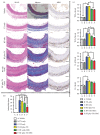A Rat Model of Radiation Vasculitis for the Study of Mesenchymal Stem Cell-Based Therapy
- PMID: 30956979
- PMCID: PMC6431386
- DOI: 10.1155/2019/3727635
A Rat Model of Radiation Vasculitis for the Study of Mesenchymal Stem Cell-Based Therapy
Abstract
Radiation vasculitis is one of the most common detrimental effects of radiotherapy for malignant tumors. This is developed at the vasculature of adjacent organs. Animal experiments have showed that transplantation of mesenchymal stem cells (MSCs) restores vascular function after irradiation. But the population of MSCs being engrafted into irradiated vessels is too low in the conventional models to make assessment of therapeutic effect difficult. This is presumably because circulating MSCs are dispersed in adjacent tissues being irradiated simultaneously. Based on the assumption, a rat model, namely, RT (radiation) plus TX (transplantation), was established to promote MSC homing by sequestering irradiated vessels. In this model, a 1.5 cm long segment of rat abdominal aorta was irradiated by 160kV X-ray at a single dose of 35Gy before being procured and grafted to the healthy counterpart. F344 inbred rats served as both donors and recipients to exclude the possibility of immune rejection. A lead shield was used to confine X-ray delivery to a 3 cm×3 cm square-shaped field covering central abdominal region. The abdominal viscera especially small bowel and colon were protected from irradiation by being pushed off the central abdominal cavity. Typical radiation-induced vasculopathy was present on the 90th day after irradiation. The recruitment of intravenously injected MSCs to irradiated aorta was significantly improved by using the RT-plus-TX model as compared to the model with irradiation only. Generally, the RT-plus-Tx model promotes MSC recruitment to irradiated aorta by separating irradiated vascular segment from adjacent tissue. Thus, the model is preferred in the study of MSC-based therapy for radiation vasculitis when the evaluation of MSC homing is demanding.
Figures





Similar articles
-
HMGB1-modified mesenchymal stem cells attenuate radiation-induced vascular injury possibly via their high motility and facilitation of endothelial differentiation.Stem Cell Res Ther. 2019 Mar 13;10(1):92. doi: 10.1186/s13287-019-1197-x. Stem Cell Res Ther. 2019. PMID: 30867070 Free PMC article.
-
Comparison of Treatments With Local Mesenchymal Stem Cells and Mesenchymal Stem Cells With Increased Vascular Endothelial Growth Factor Expression on Irradiation Injury of Expanded Skin.Ann Plast Surg. 2015 Aug;75(2):219-30. doi: 10.1097/SAP.0000000000000574. Ann Plast Surg. 2015. PMID: 26165573
-
Repeated autologous bone marrow-derived mesenchymal stem cell injections improve radiation-induced proctitis in pigs.Stem Cells Transl Med. 2013 Nov;2(11):916-27. doi: 10.5966/sctm.2013-0030. Epub 2013 Sep 25. Stem Cells Transl Med. 2013. PMID: 24068742 Free PMC article.
-
HGF and TSG-6 Released by Mesenchymal Stem Cells Attenuate Colon Radiation-Induced Fibrosis.Int J Mol Sci. 2021 Feb 11;22(4):1790. doi: 10.3390/ijms22041790. Int J Mol Sci. 2021. PMID: 33670243 Free PMC article.
-
Local irradiation not only induces homing of human mesenchymal stem cells at exposed sites but promotes their widespread engraftment to multiple organs: a study of their quantitative distribution after irradiation damage.Stem Cells. 2006 Apr;24(4):1020-9. doi: 10.1634/stemcells.2005-0260. Epub 2005 Dec 8. Stem Cells. 2006. PMID: 16339642
Cited by
-
Extracellular Vesicles Released from Stem Cells as a New Therapeutic Strategy for Primary and Secondary Glomerulonephritis.Int J Mol Sci. 2022 May 20;23(10):5760. doi: 10.3390/ijms23105760. Int J Mol Sci. 2022. PMID: 35628570 Free PMC article. Review.
References
-
- Harb A. H., Abou Fadel C., Sharara A. I. Radiation enteritis. Current Fungal Infection Reports. 2014;16(5):p. 383. - PubMed
MeSH terms
LinkOut - more resources
Full Text Sources
Medical

